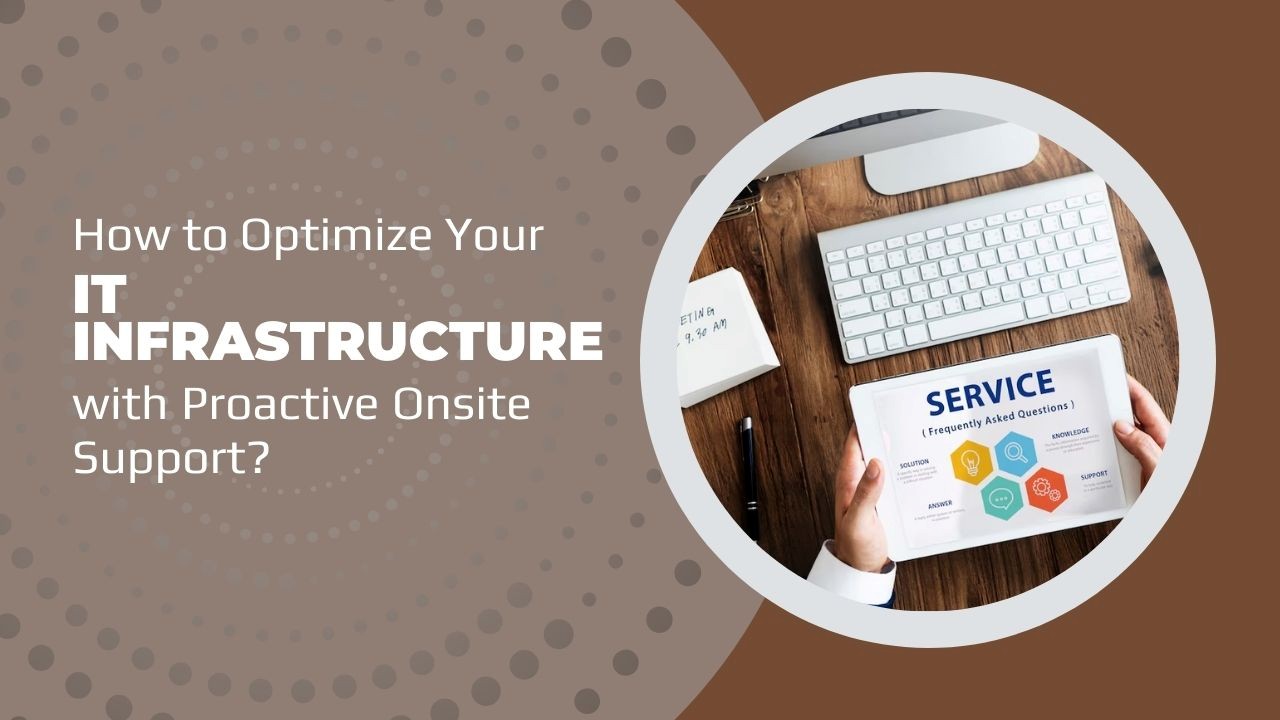How to Optimize Your IT Infrastructure with Proactive Onsite Support?
Do you run a business from an IT-powered infrastructure? If you do, for sure, it drives efficiency, innovation, and growth. But it’s also true that new technologies are rapidly evolving, which might require effort to maintain a robust and secure IT infrastructure. Ignoring this aspect can crash your business because of lengthy downtime, cyber threats, and system inefficiencies. These flaws won’t let your operations run smoothly, which leads to significant financial losses and also damages your reputation.
So! Are you ready to bear these negative things? Certainly, you won’t be. Nobody will be ready for it. Here, proactive onsite support services can prove the best alternative. With instantaneous solutions, you access advanced technologies with hands-on expertise for IT infrastructure optimization.
Importance of Proactive Onsite Support in IT Infrastructure
Traditional IT support works as a reactive model. It means that the support services will fix technical issues once they occur. This model is outstanding, particularly for the IT infrastructures that need immediate solutions. What about proactive support?
Simply put, preventing the possibility of troubleshooting, is it? Proactive onsite support emphasises monitoring and discovering potential issues before they elevate. This approach emerges as a saviour for businesses that cannot rest but uninterruptedly operate. Consider the example of advanced technologies, such as artificial intelligence, the Internet of Things (IoT), and cloud computing. These are ongoing things that continue to perform for mining business solutions. This is possible when these technologies meet specialised expertise and hands-on experience for producing maximum benefits. So, here proactive onsite support is the key to keeping modern IT infrastructure up and steadily working.
How Advanced Technologies Enhance Onsite Support Services?
New technologies are helping in achieving breakthroughs. Some advanced technologies have also evolved to power onsite support services. Let’s catch up with them below:
1. Predictive Analytics and AI-Driven Monitoring
Predictive analytics is related to foreseeing potential results, and AI enables it in the present scenario. How is it if your AI tool fails to anticipate breakdowns or loops in your data, which actually powers AI, because of a flaw in networking?
Real-Time Insights: Onsite support services enable your AI-powered monitoring tools to continue analysing vast amounts of data from a seamless IT infrastructure. It can help in detecting flaws and predicting future technical breakdowns.
Automated Alerts: When an issue is detected, the system automatically notifies onsite support teams, enabling them to address the problem before it impacts operations.
Aligning assistance for IT infrastructure management: This can be done by foreseeing potential technical glitches. The anticipation guides in scheduling the right type of onsite maintenance services before the need arises. This practice reduces downtime while enhancing the lifespan of hardware.
2. Properly handling IoT-Powered Devices
IoT-enabled devices ensure seamless connectivity in the digital landscape of your infrastructure. A little friction can stop the entire operational unit.
Remotely finding flaws: With onsite assistance, IoT sensors can be fit in IT devices. This is how the onsite support team identifies red flags to work on. These glitches can be related to their performance, temperature, and consumption of energy. These insights guide onsite technicians to optimise them correspondingly.
Real-time security alert: IoT devices can be configured to automatically inform about unauthorised access or suspicious activities. This setting will alert onsite support experts to immediately intervene and prevent security breaches.
3. Deploying Cloud and Hybrid Infrastructure
Cloud is a virtual space where virtual and hybrid infrastructure continue to discharge their functions. This technology helps in maximising the utility of onsite assistance.
Seamless Connectivity: With onsite support teams, your on-premises infrastructure can seamlessly perform with cloud services. And, you don’t have to invest time and money in optimizing performance and scalability separately. Simply optimizing cloud-based triggers can help.
Data Backup and Recovery: With proactive onsite support, you can leave worries of regulating backups aside. This will keep your disaster recovery planning steadily working well. Its positive aspect keeps businesses up and running even if instances of data loss or system failure are reported.
4. Augmented Reality (AR) for Troubleshooting
With augmented reality tools, troubleshooting is easygoing.
Remote Guidance: These tools hypothesise technology-based emergencies or breakdowns. Technicians leverage them to receive real-time guidance even if they are not available online. They fix it before the issue escalates, which reduces resolution times and improves accuracy.
Tools to train: AR tools inform about potential glitches in technology. The technicians can use them to monitor, learn, and troubleshoot successfully.
5. Cybersecurity is a Priority
Malicious cyberattacks are consistently reported, which can be countered with proactive security settings.
Identify threats: When advanced cybersecurity tools are combined with onsite support, they work wonders. A multi-layered defense system is created, which fights cyber threats effectively.
Incident response: If somehow a case of security breach comes to notice, onsite teams can instantly discover and hence, proactively control the damage. This is how downtime can be reduced while restoring normalcy in IT operations.
Benefits of Proactive Onsite Support
Onsite support for a business adds multiple advantages, which are given below:
- The substantial benefit of onsite support emerges when the issue is not yet escalated and the support team gets clues to ensure uninterrupted operations for maximum productivity.
- Preventive measures for maintenance and early problem detection lower the need for lengthy downtimes & emergencies for repairs that cost a lot.
- The manual presence of an onsite support team provides an additional layer of protection against cyberattacks, which secures data and maintains reputation.
- With automated tools, onsite tech engineers stay informed about key performance areas where glitches may occur and how to troubleshoot consistently for optimised infrastructure.
- If there emerges any need for scaling IT infrastructure, the informed onsite engineers can find opportunities by leveraging new technologies.
How to Implement Proactive Onsite Support?
For those who are actively involved in it, they know these proven steps. Here they are:
Step 1. Discover all key aspects or touchpoints of IT infrastructure that may require consistent monitoring and assistance. For instance, your hardware, software, or network systems often require troubleshooting.
Step 2. Hire or contract with an esteemed IT service provider that has been consistently serving proactively, and customers rate it with four or five in reviews.
Step 3. Fixing and enhancing onsite assistance capacities requires a blend of AI tools, IoT devices, and advanced cybersecurity solutions. Allow this combination to work.
Step 4. Train your onsite IT engineers so that they can be well-equipped with the latest technologies and troubleshooting techniques.
Step 5. Steadily monitor the performance of your IT infrastructure while optimizing it from time to time to maintain its efficiency.
Conclusion
In a nutshell, optimizing an IT infrastructure is not possible without proactive onsite support. This support can be further refined and customised while integrating speed in troubleshooting with the help of advanced tools. These initiatives, when combined with hands-on experience, enable you to see seamless operations, enhanced security, and growth.


